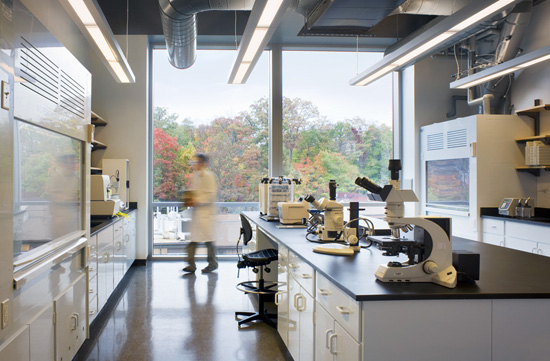
One of the important aspects of our practice is to follow up with those who work and learn in the buildings we design, not only when it first becomes occupied, but over the life span of the building as well. The Post Occupancy Evaluation (POE) is the vehicle PAYETTE uses to obtain this valuable feedback. We use this information to improve the operation of the building, applying the “lessons learned” on future projects. This is a fundamental piece of our evidence-based design practice. Multiple sources of information, from researchers, facilities management, administration, faculty, students and staff are included. The scope and focus of each POE is tailored to the specific goals and attributes of the project.
The POE often produces a tidal wave of information requiring the evaluator to sift through myriad responses and data; a task that can sometimes seem insurmountable. We work to understand how users feel about their new space using both surveys and face-to-face interviews in order to learn how the space is performing in relation to how we thought it would perform during the design process. For example, the information that 61% of people working in labs never adjust their casework after move in may affect how we consider adjustable lab benches. Or, for instance, though there are typically many comments about temperature and comfort, more than 70% of occupants are satisfied with the temperature of their spaces.
The two processes, survey and interview, provide us with different types of information: The survey supplies us with comparable data; the interview with feelings, anecdotal stories and conversational opinions about what life is really like for those who occupy the building. Navigating between the two types of information requires some effort and certainly more than one look.
Typically we issue the survey prior to the interview – this sets the stage for the questions we ask during the interview process. After we receive all responses, we pour over the replies to understand general performance trends. Questions on the survey focus on the various users: facilities and building operations, researchers, students, administrators, etc. Additionally, we ask questions about key spaces for each of those groups, like, “how easy is the space to maintain?” and “how do you like the casework?”
When we have the opportunity to follow up with an interview it’s important to send a staff member from PAYETTE who was not involved in the project through its many phases. We strive to be receptive to those responding in the interview. Like any productive conversation, it’s important to listen actively, not defend a project but carefully acknowledge and document the comments in the most objective manner possible.
The two-phased POE approach serves to deliver a well rounded assessment of the project, keeping in mind that we are not investigating/diagnosing problems or successes but rather we are looking for an indication of how the building is performing a year or more after occupancy.
Following the completion of the POE, we gather information in a database with which we compare and contrast design elements, which helps us celebrate and continue successful design responses and subsequently, determine which elements could be improved in future projects.


